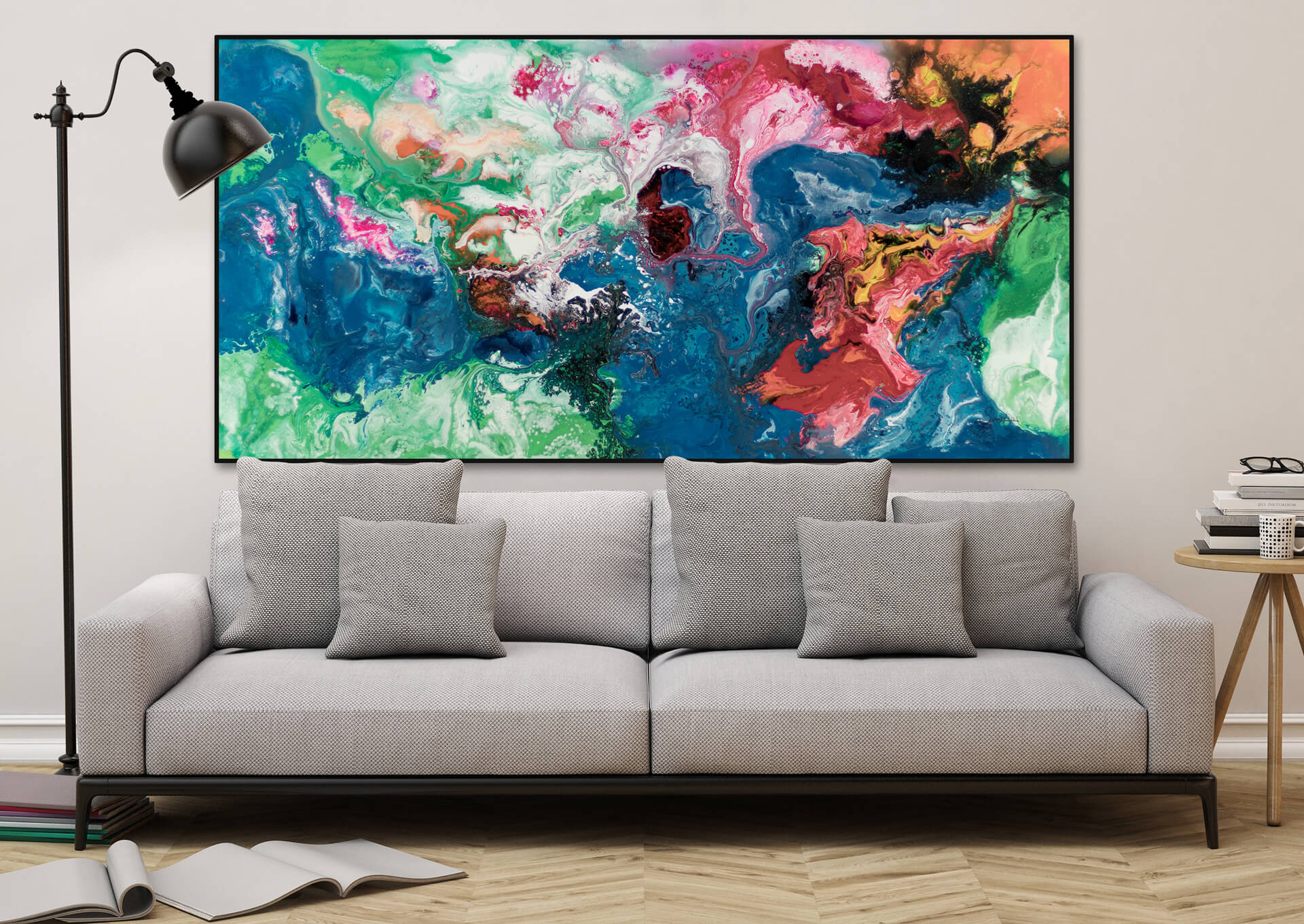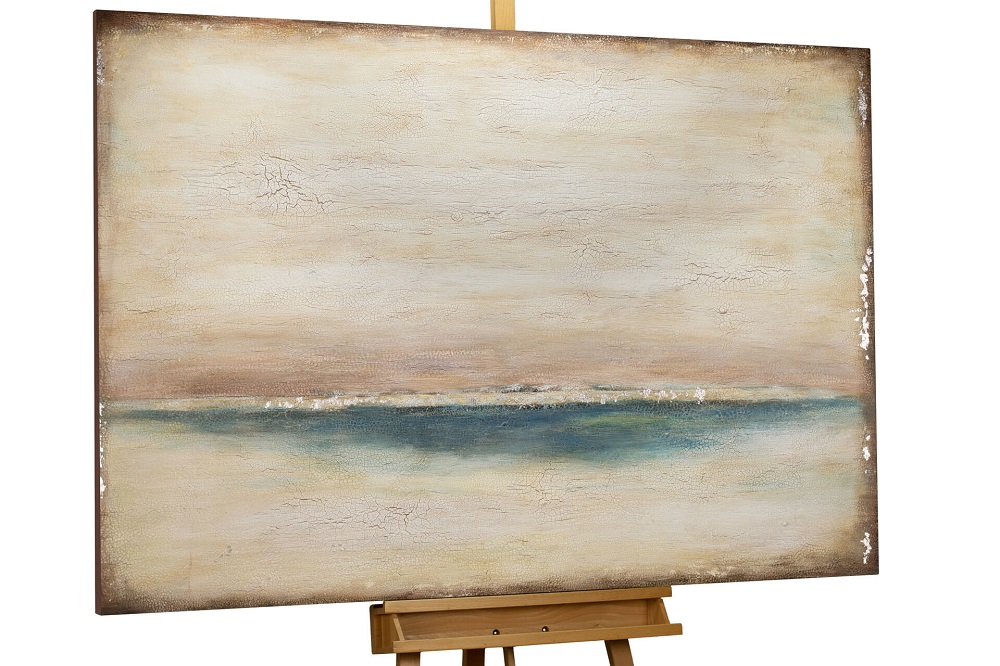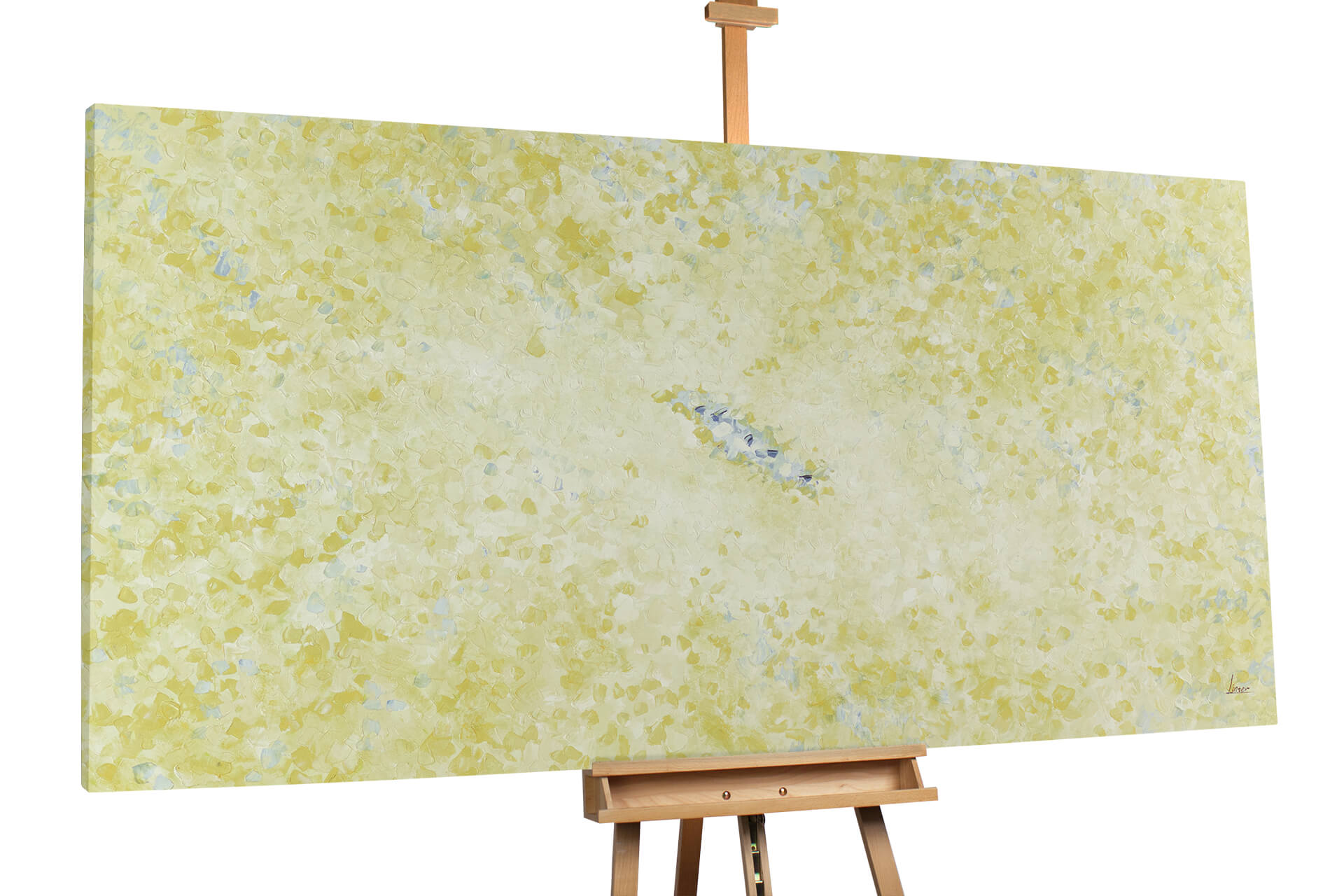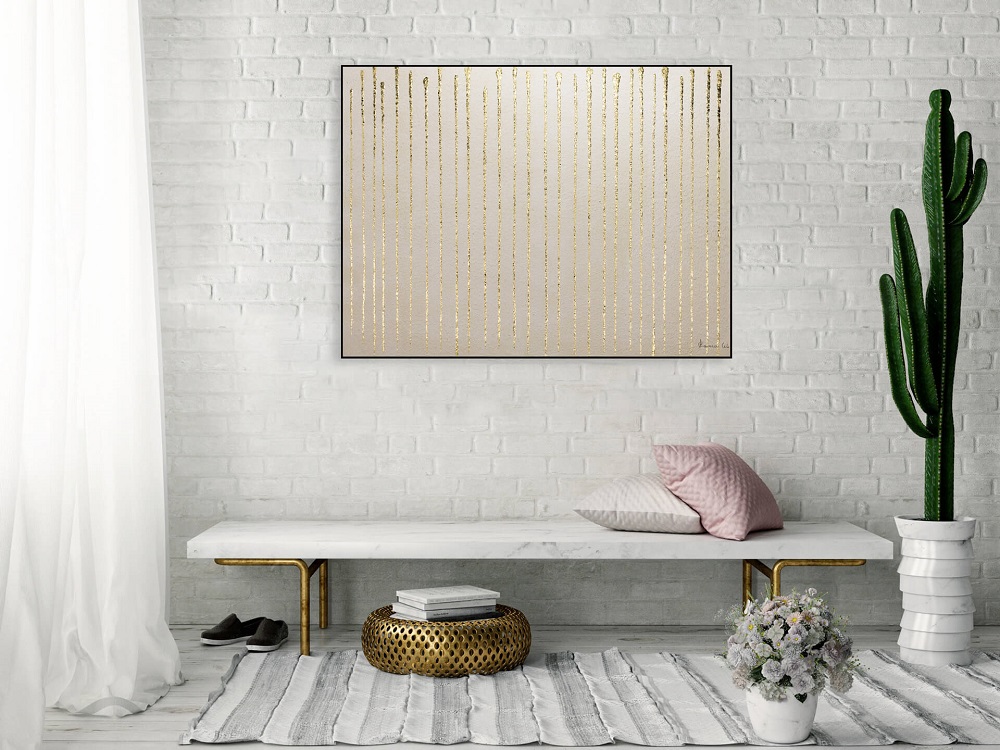From Kandinsky to O`Keefe: A portrait of 10 famous abstract artists
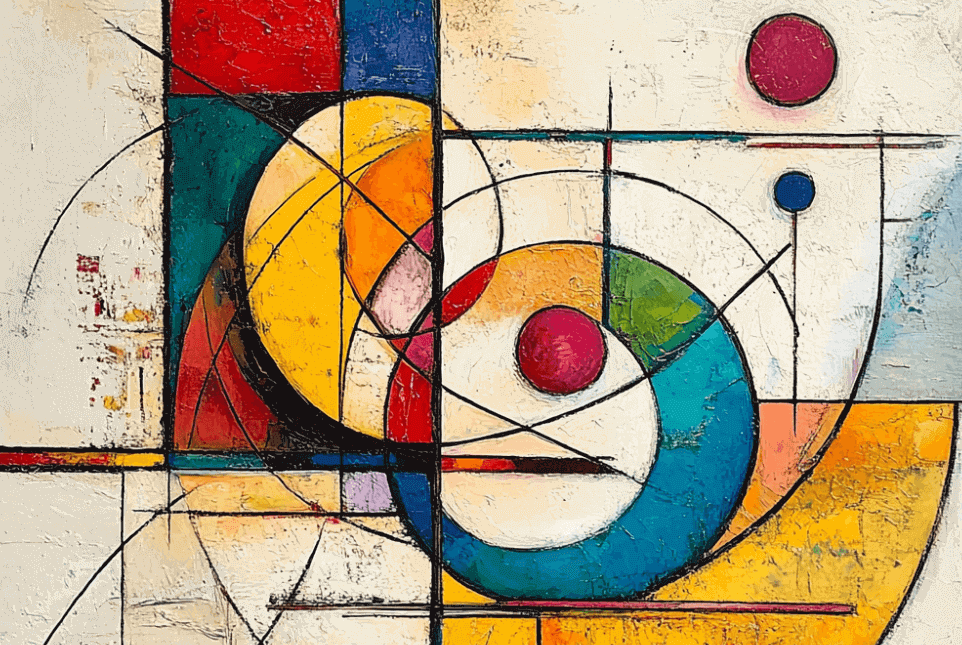
Abstract art is art that is detached from the representational. Since the beginning of the 20th century, numerous artists have left their mark on this art movement – we present some of the most famous abstract artists here.
Table of contents:
10 famous abstract artists
Mondrian’s geometric compositions with red, yellow and blue in black grids, O’Keefe’s floral abstractions or Pollock’s Drip Paintings – they all celebrate abstraction. Get to know ten well-known artists who influenced 20th century abstract art in their own unique way.
1. Wassily Kandinsky (1866 – 1944)
The Russian painter Wassily Kandinsky is considered one of the pioneers of abstract art. While he still devoted himself to Expressionism in his early works, he turned more and more to abstraction from 1908 onwards. In 1911, together with Franz Marc, he founded the artists’ group “Der Blaue Reiter” (The Blue Rider) in Munich, in which the artists wanted to follow their inner voice rather than paint according to real nature. In Kandinsky’s later works, the representational dissolves into colours and forms. Today, his paintings are in the world’s great art collections.
Famous works:
- “Improvisation 26 (Rowing)” (1912)
- “Composition VII” (1913)
- “Yellow, Red, Blue” (1925)
2. Piet Mondrian (1872 – 1944)
He is considered the founder of Neoplasticism, an “ideal art” reduced to the essentials: when the Dutchman Piet Mondrian discovered the Cubist art of Georges Braque and Pablo Picasso in Paris in 1911, they inspired him to develop his own abstract formal language. With the artists’ group “De Stijl”, Mondrian developed a new art from 1917 onwards: paintings, furniture and architecture were created that were limited to the primary colours red, blue and yellow as well as the non-colours white and black and were permeated by horizontal and vertical lines. Neo-Plasticism was born! In 1921, Mondrian created his most famous painting to this day: “Composition with Red, Yellow, Blue and Black”.
Famous works:
- “Composition with Red, Yellow, Blue and Black” (1921)
- “Composition A” (1923)
- “Broadway Boogie Woogie” (1943)
3. Kasimir Malewitsch (1878 – 1935)
Kiev-born Kazimir Malevich developed his own abstract style, Suprematism. In his manifesto “From Cubism to Suprematism”, published in 1915, he called for an absolute non-objective painting reduced to the basic geometric shapes, rectangle, triangle and circle. In addition, Malevich used exclusively the non-colours black and white for numerous compositions, such as his “Black Square” created in Paris in 1915 or the “Black Cross” (1923).
Famous works:
- “Black Square” (1915)
- “Eight Rectangles” (1915)
- “White on White” (1917)
4. Hilma af Klint (1882-1944)
After a classical art education, the Swedish artist Hilma af Klint devoted herself to landscape painting, but she soon discovered abstraction for herself: under the influence of spiritualism, the imaginary and visionary became the focus of her art. The realistic depiction of material objects thus receded into the background; af Klint was much more concerned with the depiction of subtle perceptions – in abstract forms. Finally, in 1906, Hilma af Klint painted her first non-figurative picture – and thus years earlier than Wassily Kandinsky, who was long considered the originator of the first abstract painting.
In later years, it is not so much spiritualistic sessions that influence af Klint’s art as intensive experiences of nature. Nature – flowers, moss, snail shells – became the source of her inspiration. In the course of her life, Hilma af Klint created more than 1000 drawings and paintings in a largely abstract style. After her death in 1944, her work remained under lock and key for around four decades until her nephew finally made it accessible to the public. Today she is considered one of the pioneers of abstract painting and an outstanding artist of the 20th century.
Famous works:
- “The Ten Greatest, No. 2” (1907)
- “Altarpiece No. 1, Group X” (1915)
- “The Swan (No. 17)” (1915)
5. Georgia O’Keeffe (1887 – 1986)
She was one of the first representatives of American modernism and created an extensive oeuvre over seven decades: Georgia O’Keeffe, who was born in the US state of Wisconsin, was mainly influenced by the natural world, such as flowers and landscapes. She sought innovative forms of expression, far removed from traditional art styles, and combined elements of abstraction and figurative representation in her work. O’Keeffe’s large-format flower paintings, which were often interpreted as a representation of the female anatomy, are particularly well known – the painter herself, however, referred to the abstract character of her art, which is only charged with meaning by the viewer.
Famous works:
- “Red Canna” (1924)
- “Cow Skulls: Red, White and Blue” (1931)
- “From afar, near” (1937)
6. Mark Rothko (1903 – 1966)
The Russian-American artist Mark Rothko tried his hand at a number of artistic styles until he finally became a pioneer of colour field painting. From 1950 onwards, he painted large-format monochrome colour fields arranged above and next to each other to create a special kind of geometric abstraction. Rothko’s choice of colours and the resulting contrasts were just as calculated as the effects of space and light. His paintings often give the impression that the blocks of colour glow from within or float in front of the coloured background. Rothko’s aim was to arouse emotions and create spiritual experiences in the viewer through colour alone – and indeed many people compare Rothko’s art to religious experiences.
Rothko was a leading member of the abstract artist group “New York School” and, along with Jackson Pollock, is considered the most important representative of American abstract expressionism.
Famous works:
- “No. 10” (1950)
- “No. 21” (Red, Brown, Black and Orange) (1951)
- “Untitled (Black on Gray)” (1970)
7. Clyfford Still (1904 – 1980)
In the 1940s, the American artist Clyfford Still developed his own pure abstract expressionist style. The core theme of his art was the existential struggle of life against death, of the human spirit against the forces of nature. Still expressed this struggle in vertical forms that reflect the upright gait of man or the upright growth of plants – while all living beings assume a position in the horizontal with death. His paintings show large-scale, jagged forms; one or a few dominant colours prevail. Thanks to the impasto technique, in which the colours are applied very thickly, a dynamic contrast is created between the dominant colour field and the accent colours.
Famous works:
- “1944-N No.2” (1944)
- “PH-2472 (1951)
- “1956-D” (1956)
8. Willem de Kooning (1904 – 1997)
The female form was at the centre of Willem de Kooning’s abstract painting. The Dutch-American painter is one of the main representatives of abstract expressionism, whereby his style moves between abstraction and figuration: he distorts human figures in such a way that they look like abstract shapes and lines.
De Kooning is often mentioned in the same breath as Jackson Pollock and Mark Rothko, his fellow artists who, together with him, shaped American abstract art and made New York an art metropolis after 1945. Together with Jackson Pollock, Willem de Kooning is considered the founder of action painting, an intuitive style of painting in which artists let their energies flow freely and paint with full physical effort.
Today, Willem de Kooning’s paintings regularly sell for record sums. For example, his painting “Exchange” (1955) fetched 300 million dollars in 2015 – at the time the highest price ever paid for a painting.
Famous works:
- “Pink Angels” (1945)
- “Woman III” (1953)
- “Gotham News” (1955)
9. Jackson Pollock (1912 – 1956)
The name Jackson Pollock is closely associated with abstract expressionism. The American painter is famous for the style of drip painting he developed, a form of action painting or fluid painting: Pollock dripped, splashed and poured liquid paint onto large-format canvases that lay on the floor and which he painted from all sides. Increasingly, all narrative elements disappeared from Pollock’s paintings or were overlaid by the layers and splashes of paint he applied later.
In 1943, the New York art patron Peggy Guggenheim organised Jackson Pollock’s first solo exhibition. His paintings, which were created during the “drip phase”, caused a sensation – to this day, Pollock’s works are traded at top prices in the art scene.
Famous works:
- “Red Composition” (1946)
- “Number 19, 1948” (1948)
- “Number 1, 1950 (Lavender Mist)” (1950)
Tip: Discover fascinating paintings in the style of Action Painting or Fluid Painting at KunstLoft.
10. Agnes Martin (1912-2004)
Minimalism characterises the paintings of abstract artist Agnes Martin: instead of depicting representational objects, the US-American wanted to evoke emotions with her works. Her large-format canvases are criss-crossed with fine horizontal and vertical lines, the colours are very delicate, subtle and transparent. The viewer has to take his or her time, close the distance to the painting and enlarge it again, so that its full effect unfolds.
Agnes Martin achieved her breakthrough in the 1960s with these extraordinary works. But in 1967 she turned her back on the noisy, male-dominated art world of New York, travelled through the USA and Canada and finally settled in the seclusion of New Mexico. There, from 1972 onwards, her second major creative phase began: the lines in her paintings are now sharper and clearer; recurring symmetries of delicate watercolour tones pervade her entire oeuvre.
To this day, Agnes Martin is considered an icon of abstract expressionism and minimalism, impressing and inspiring numerous artists.
Famous works:
- “The Islands” (1961)
- “On a Clear Day” [Series] (1973)
- “Untitled No. 4” (1994)
Are you fascinated by Minimal Art? Discover our discreet, clear artworks in minimalist style!
Interesting facts about abstract art and its artists
Frequently asked questions about abstract art and its representatives are answered here.
What is abstract art?
The collective term “abstract art” refers to various art movements of the 20th century that have emerged since 1900. The characteristic of abstract art is that it is “non-objective” (hence also “non-objective art”): Abstract artists move away from the depiction of figures or objects, or real nature, and instead depict abstract forms. Well-known abstract art styles are, for example, Cubism, Constructivism, Geometric Abstraction, Abstract Expressionism and Art Informel.
Who painted the first abstract picture?
Hilma af Klint (1882-1944) is considered the first artist to devote herself to painting abstract pictures (not Kandinsky, as long assumed). She created her first abstract painting as early as 1906.
Who are famous abstract artists from Germany?
Well-known German representatives of abstract art are, for example, Willi Baumeister, Gerhard Richter, Georg Baselitz or Anselm Kiefer.
Who were famous female abstract artists?
The most famous female abstract artists include Hilma af Klint, Agnes Martin, Georgia O’Keeffe, Bridget Riley, Helen Frankenthaler and Joan Mitchell.
Abstract art for your walls - from KunstLoft or self-painted
The list of famous and pioneering abstract artists is long and the diversity of abstract art fascinating. With our small selection of important abstract artists, we hope we could inspire you for this art movement.
Discover a large selection of abstract wall paintings or sculptures in the KunstLoft shop that will create a wow effect in your rooms!
Or have you now got the urge to pick up a paintbrush yourself? In our beginner’s guide “Painting abstract pictures” you will learn everything you need to know as a painting beginner. Read more exciting artist portraits in our article on “Famous graffiti artists“.
Photo credits: Images: © KunstLoft


